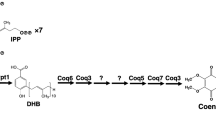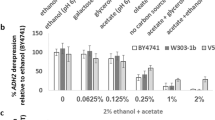Abstract
Addition of glucose to derepressed cells of the yeast Saccharomyces cerevisiae induces a transient, specific cAMP signal. Intracellular acidification in these cells, as caused by addition of protonophores like 2,4-dinitrophenol (DNP) causes a large, lasting increase in the cAMP level. The effect of glucose and DNP was investigated in glucose-repressed wild type cells and in cells of two mutants which are deficient in derepression of glucose-repressible proteins, cat1 and cat3. Addition of glucose to cells of the cat3 mutant caused a transient increase in the cAMP level whereas cells of the cat1 mutant and in most cases also repressed wild type cells did not respond to glucose addition with a cAMP increase. The glucose-induced cAMP increase in cat3 cells and the cAMP increase occasionally present in repressed wild type cells however could be prevented completely by addition of a very low level of glucose in advance. In derepressed wild type cells this does not prevent the specific glucose-induced cAMP signal at all. These results indicate that repressed cells do not show a true glucose-induced cAMP signal. When DNP was added to glucose-repressed wild type cells or to cells of the cat1 and cat3 mutants no cAMP increase was observed. Addition of a very low level of glucose before the DNP restored the cAMP increase which points to lack of ATP as the cause for the absence of the DNP effect. These data show that intracellular acidification is able to enhance the cAMP level in repressed cells. The glucose-induced artefactual increase occasionally observed in repressed cells is probably caused by the fact that their low intracellular pH is only restored after the ATP level has increased to such an extent that it is no longer limiting for cAMP synthesis. It is unclear why the artefactual increases are not always observed. Measurement of glucose- and DNP-induced activation of trehalase confirmed the physiological validity of the changes observed in the cAMP level. Our results are consistent with the idea that the glucose-induced signaling pathway contains a glucose-repressible protein and that the protein is located before the point where intracellular acidification triggers activation of the pathway.
Similar content being viewed by others
Abbreviations
- CCCP:
-
carbonyl cyanide m-chlorophenylhydrazone
- DNP:
-
2,4-dinitrophenol
- Mes:
-
4-morpholineethanesulfonic acid
References
Beullens M, Mbonyi K, Geerts L, Gladines D, Detremerie K, Jans AWH, Thevelein JM (1988) Studies on the mechanism of the glucose-induced cAMP signal in glycolysis and glucose repression mutants of the yeast Saccharomyces cerevisiae. Eur J Biochem 172: 227–231
Caspani G, Tortora P, Hanozet GM, Guerritore A (1985) Glucose-stimulated cAMP increase may be mediated by intracellular acidification in Saccharomyces cerevisiae. FEBS Lett 186: 75–79
Celenza JL, Carlson M (1986) A yeast gene that is essential for release from glucose repression encodes a protein kinase. Science 233: 1175–1180
den Hollander JA, Ugurbil K, Brown TR, Shulman RG (1981) 31P-NMR studies of the effect of oxygen upon glycolysis in yeast. Biochemistry 20: 5871–5880
Entian KD, Zimmermann FK (1982) New genes involved in carbon catabolite repression and derepression in the yeast Saccharomyces cerevisiae. J Bacteriol 151: 1123–1128
Eraso P, Mazon MJ, Gancedo JM (1987) Internal acidification and cAMP increases are not correlated in Saccharomyces cerevisiae Eur J Biochem 165: 671–674
Gibbs JB, Marshall MS (1989) The ras oncogene — an important regulatory element in lower eucaryotic organisms. Microbiol Rev 53: 171–185
Matsumoto K, Uno I, Ishikawa T (1985) Genetic analysis of the role of cAMP in yeast. Yeast 1: 15–24
Mazon MJ, Gancedo JM, Gancedo C (1982) Phosphorylation and inactivation of yeast fructose-bisphosphatase in vivo by glucose and proton ionophores. Eur J Biochem 127: 605–608
Mbonyi K, Beullens M, Detremerie K, Geerts L, Thevelein JM (1988) Requirement of one functional RAS gene and inability of an oncogenic ras variant to mediate the glucose-induced cyclic AMP signal in the yeast Saccharomyces cerevisiae. Mol Cell Biol 8: 3051–3057
Munder T, Küntzel H (1989) Glucose-induced cAMP signaling in Saccharomyces cerevisiae is mediated by the CDC25 protein. FEBS Lett 242: 341–345
Nikawa J, Cameron S, Toda T, Ferguson KM, Wigler M (1987) Rigorous feedback control of cAMP levels in Saccharomyces cerevisiae. Genes Dev 1: 931–937
Purwin C, Leidig F, Holzer H (1982) Cyclic AMP dependent phosphorylation of fructose-1,6-bisphosphatase in yeast. Biochem Biophys Res Commun 107: 1482–1489
Purwin C, Nicolay K, Scheffers WA, Holzer H (1986) Mechanism of control of adenylate cyclase activity in yeast by fermentable sugars and carbonyl cyanide m-chlorophenylhydrazone. J Biol Chem 261: 8744–8749
Ramos S, Balbin M, Raposo M, Valle E, Pardo LA (1989) The mechanism of intracellular acidification induced by glucose in Saccharomyces cerevisiae. J Gen Microbiol 135: 2413–2422
Schuller HJ, Entian KD (1988) Molecular characterization of yeast regulatory gene CAT3 necessary for glucose derepression and nuclear localization of its product. Gene 67: 247–257
Thevelein JM (1988) Regulation of trehalase activity by phosphorylation-dephosphorylation during developmental transitions in fungi. Exp Mycol 12: 1–12
Thevelein JM, Beullens M, Honshoven F, Hoebeeck G, Detremeric K, Griewel B, den Hollander JA, Jans AWH (1987b) Regulation cAMP level in the yeast Saccharomyces cerevisiae: intracellular pH and the effect of membrane depolarizing compounds. J Gen Microbiol 133: 2191–2196
Thevelein JM, Beullens M, Honshoven F, Hoebeeck G, Detremerie K, Griewel B, den Hollander JA, Jans AWH (1987b) Regulation of the cAMP level in the yeast Saccharomyces cerevisiae: the glucose-induced cAMP signal is not mediated by a transient drop in the intracellular pH. J Gen Microbiol 133: 2197–2205
Valle E, Bergillos L, Gascon S, Parra F, Ramos S (1986) Trehalase activation in yeasts is mediated by an internal acidification. Eur J Biochem 154: 247–251
Van der Plaat JB (1974) Cyclic 3′,5′-adenosinc monophosphate stimulates trehalose degradation in baker's yeast. Biochem Biophys Res Commun 56: 580–587
Zimmermann FK, Kaufmann I, Rasenberger H, Haussmann P (1977) Genetics of carbon catabolite repression in Saccharomyces cerevisiae: genes involved in the derepression process. Mol Gen Genet 151: 95–103
Author information
Authors and Affiliations
Rights and permissions
About this article
Cite this article
Argüelles, JC., Mbonyi, K., Van Aelst, L. et al. Absence of glucose-induced cAMP signaling in the Saccharomyces cerevisiae mutants cat1 and cat3 which are deficient in derepression of glucose-repressible proteins. Arch. Microbiol. 154, 199–205 (1990). https://doi.org/10.1007/BF00423333
Received:
Accepted:
Issue Date:
DOI: https://doi.org/10.1007/BF00423333




